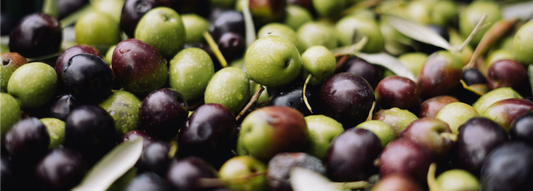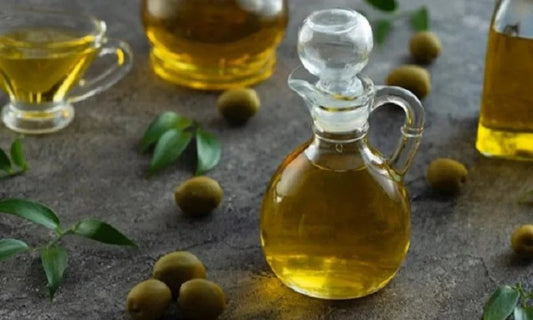Olive oil has been consumed by people for thousands of years and is a staple in the Mediterranean diet and European cuisines.1 It contains no carbohydrates or protein. All of its calories come from fat, mostly good-for-you monounsaturated fat, making it a nutritious addition to your diet.2
Olive oil can vary in terms of color and flavor. Whether it is labeled virgin, extra-virgin, or pure depends on how acidic it is and how much it has been processed. Unlike oils that are extracted from a seed, nut, or grain, olive oil is extracted from the fruit itself.
Olive Oil Nutrition Facts
The following nutrition information is provided by the USDA.
|
Carbs
There are no carbohydrates in olive oil.
Fats
One tablespoon of olive oil contains 9.86 grams of monounsaturated fat, 1.42 grams of polyunsaturated fat, and 1.86 grams of saturated fat. Although a majority of the fat is the good kind,2 it's still beneficial to control your intake since it is calorically dense.
Protein
Olive oil doesn't contain any protein.
Vitamins and Minerals
There are approximately 1.9 milligrams of vitamin E in one tablespoon of olive oil. Vitamin E helps keep our cells healthy by helping to protect them from free radicals while also boosting immunity and preventing blood from clotting within the blood vessels.4
This same amount of olive oil also contains 8.1 micrograms of vitamin K. This vitamin plays a role in many functions, some of which include blood clotting, bone metabolism, and bone mineralization.5
Consuming olive oil provides trace amounts of potassium, roughly 0.1 milligrams per tablespoon. Potassium supports healthy function of the kidneys and heart; it also plays an active role in muscle contraction
Olive Oil Calories
One tablespoon of olive oil contains 119 calories, making it a calorically-dense food. If you reduce the amount to one teaspoon, the calorie count decreases by roughly two-thirds, or closer to 40 calories per serving.
All oils are pure fats and so contain the same amount of calories per tablespoon. For instance, corn oil, sesame oil, walnut oil, peanut oil, and canola oil all contain about 120 calories per tablespoon.
However, butter contains fewer calories than olive oil because it still contains milk solids. Butter has 102 calories per tablespoon but much less monounsaturated fat per serving and much more saturated fat than olive oil with 7.2g (olive oil has 1.9g of saturated fat per tbsp).
Health Benefits
Adding olive oil to your diet appears to provide quite a few health benefits.
Boosts Immunity
Olive oil is rich in vitamin E, a fat-soluble vitamin that plays a role in immunity and disease prevention.8 Some studies also suggest that including olive oil in your diet may help in the management of immune-inflammatory diseases, such as rheumatoid arthritis and inflammatory bowel disease.
Improves Cardiovascular Health
The polyphenols in olive oil may help protect the heart. This is because the polyphenols can stop blood platelets from clumping together, which is a cause of heart attacks.10 The vitamin K in olive oil also aids in blood clotting.5
According to research, consuming more than half a tablespoon of olive oil a day may lower heart disease risk.11 Olive oil contains the highest percentage of monounsaturated fat, lowers blood pressure, and provides plant compounds with anti-inflammatory and antioxidant properties that are protective against diseases, including heart disease. As well another study showed people who consume more than half a tablespoon per day tend to have lower rates of premature death from cardiovascular disease.12
The U.S. Food and Drug Administration supports eating 1.5 tablespoons (20 grams) of olive oil each day to help reduce the risk of coronary heart disease.13
Supports Healthy Cholesterol Levels
Olive oil is high in monounsaturated fat, which has been shown to increase "good cholesterol," or HDL, and lower "bad cholesterol," or LDL.14 While the body does need some cholesterol for cellular and hormonal health, high cholesterol levels can increase the risk of heart attack and stroke.15
Reduces Inflammation
A high c-reactive protein (CRP) level is a sign that inflammation exists in the body. Some studies suggest that adding extra virgin olive oil to the diet (about one to two tablespoons per day) can have anti-inflammatory effects by reducing CRP.10
Protects Brain Function
Research suggests that consuming olive oil could offer protection from cognitive decline.16 This is even more important as we age when cognitive performance tends to naturally slow, and it may become harder to recall certain things.17 Research on olive oil shows that those who consume over half a tablespoon per day tend to have less incidence of Alzheimer's disease.
Allergies
Allergies to olive pollen appear to be somewhat common in Mediterranean countries where olive trees are cultivated. But an allergy to olives or olive oil is relatively rare—both when consumed as a food and if applied topically. The allergens most often come from pollen rather than the fruit.
Adverse Effects
Olive oil is generally deemed as safe.19 However, consuming too much can have negative effects on the way the body metabolizes lipids (fats).20So, moderation is key to enjoying the benefits olive oil provides without increasing health risks.
If you have xerosis (abnormally dry skin) or atopic dermatitis (red and itchy skin) and apply olive oil topically to relieve the itch, it may make these conditions worse.
Varieties
Olive oil varies in color and flavoring depending on the ripeness of the olives, climate, type of soil, and producer preferences. Color, which can vary from dark green to almost clear, depends on the refining process and is not a good indicator of flavor. A good quality olive oil will be thicker than refined products, but not too thick.
The label designations of virgin, extra-virgin, and pure olive oil refer to the level of acidity of the oil as well as the extent of processing used to extract the oil. The general rule of thumb is: The lower the acidity, the better.22
Virgin olive oil is 100% unadulterated olive oil, meaning it is not heated or chemically processed. Instead, it is extracted from the olives purely by mechanical means (either by pressing or spinning the olives after they are mashed into a paste). The most superior "extra virgin" has the most nutrition, lower acidity than virgin olive oil, very low rancidity, and the strongest olive flavor.
Pure olive oil is processed from the pulp after the first pressing using heat and chemicals. It is lighter in flavor and less expensive. The benefit here is that it has a more neutral flavor and a higher smoke point.
When It's Best
Olive oil, or sweet oil as it is sometimes called, is mostly produced in Europe (Spain, Italy, France, and Greece). A small amount is produced in California and North Africa.
The olive harvest occurs during the winter months (October through January) in areas north of the equator and in late spring to early summer (April through July) in the Southern Hemisphere.23
You can get olive oil at your local grocery market any time of the year. Just be sure to pay attention to the use-by date on the container. Once the product has passed that date, it may not contain all of its beneficial qualities.
Storage and Food Safety
The fats in olive oil make it susceptible to going rancid. (You know oil is rancid when it smells or tastes off.) Therefore, it is important to protect it from light and heat. To keep oil in the best condition:
- Purchase olive oil in dark glass bottles. Yellow and green glass block the damaging light rays that can cause oil to go rancid.
- Avoid purchasing bottles of oil that are dusty or have been sitting on the shelves for months. Instead, look to see if there is a date on the label and try to get the freshest oil you can.
- Store olive oil in a dark, cool place or the refrigerator until ready to use. When refrigerated, don't be alarmed if the oil appears cloudy and thick. It will become a liquid again once it returns to room temperature.
How to Prepare
Use extra-virgin olive oil to sauté meat, fish, and poultry, or to add healthy fats and flavor to frozen meals. You can also add it to soups, stews, and bean dishes or to dress roasted or raw veggies. Olive oil is a common ingredient in many of the best salad dressings.
When cooking at higher heats, such as roasting or frying, use extra virgin olive oil. Recent literature suggests that high-quality extra virgin olive oil that has not been mixed with other oils or refined is highly stable when heated and does not break down into harmful compounds.26
Use olive oil moderately in cooking and dressing food, particularly if you're watching your fat and calorie intake, since a little goes a long way. It's also important to note that one serving of fat is about one teaspoon of olive oil. (You may have to convert grams to teaspoons when calculating how much oil to use.)




